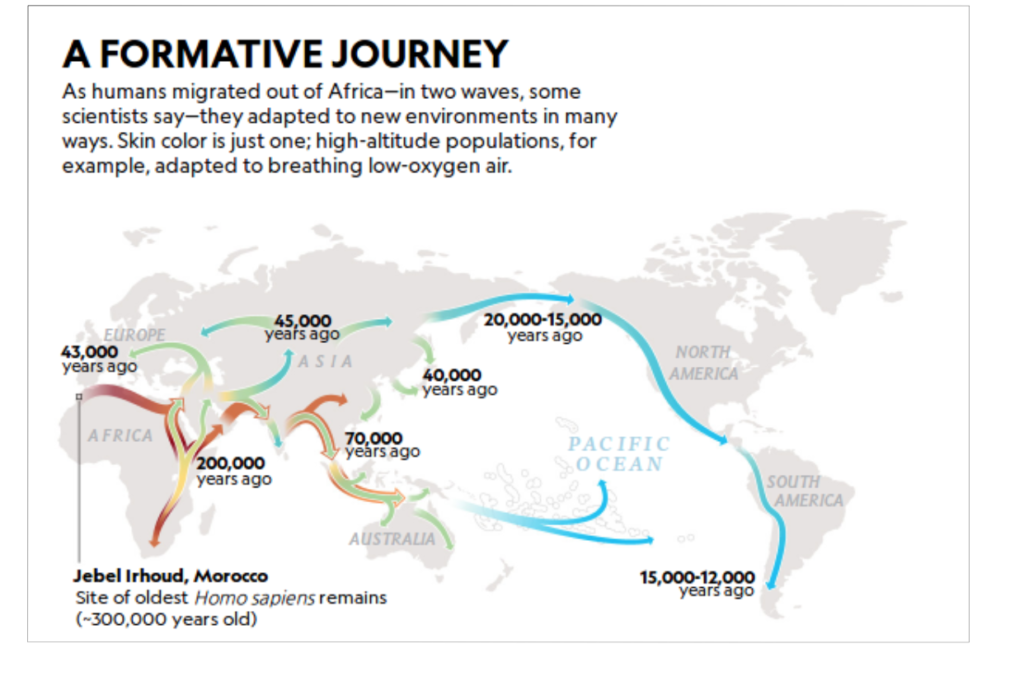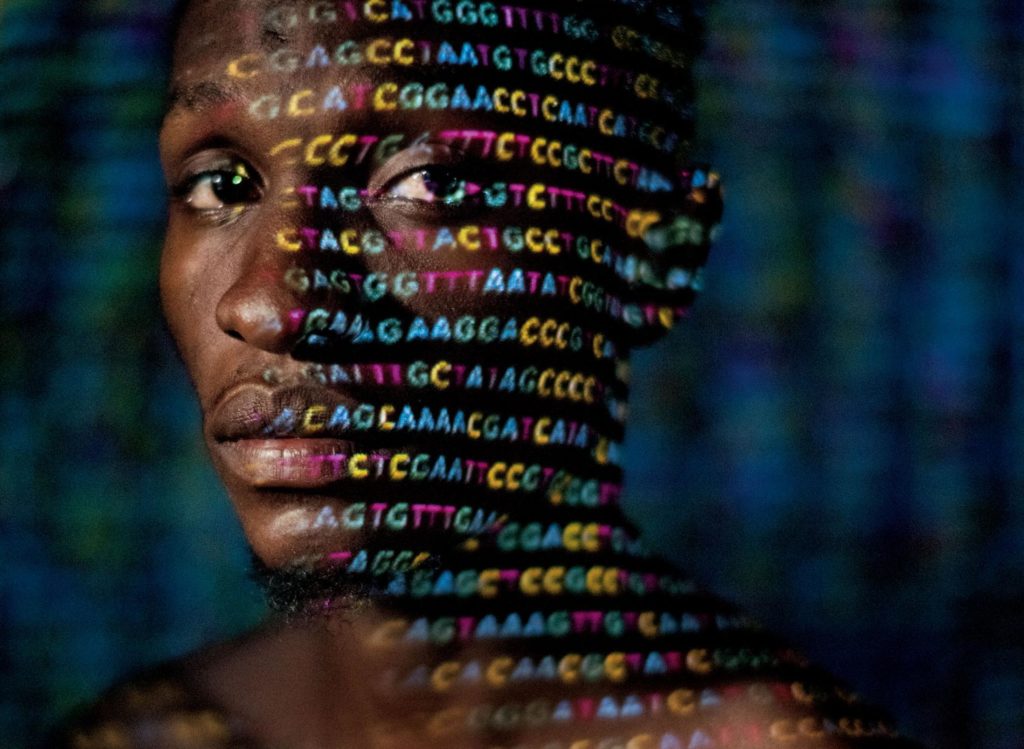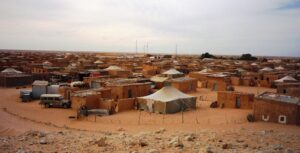Elizabeth Kolbert
In the first half of the 19th century, one of America’s most prominent scientists was a doctor named Samuel Morton. Morton lived in Philadelphia, and he collected skulls.
He wasn’t choosy about his suppliers. He accepted skulls scavenged from battlefields and snatched from catacombs. One of his most famous craniums belonged to an Irishman who’d been sent as a convict to Tasmania (and ultimately hanged for killing and eating other convicts). With each skull Morton performed the same procedure: He stuffed it with pepper seeds—later he switched to lead shot—which he then decanted to ascertain the volume of the braincase.
Morton believed that people could be divided into five races and that these represented separate acts of creation. The races had distinct characters, which corresponded to their place in a divinely determined hierarchy. Morton’s “craniometry” showed, he claimed, that whites, or “Caucasians,” were the most intelligent of the races. East Asians—Morton used the term “Mongolian”—were one step down. Next came Southeast Asians, followed by Native Americans. Blacks, or “Ethiopians,” were at the bottom. In the decades before the Civil War, Morton’s ideas were quickly taken up by the defenders of slavery. When Morton died, in 1851, the Charleston Medical Journal in South Carolina praised him for “giving to the negro his true position as an inferior race.”
Today Morton is known as the father of scientific racism. So many of the horrors of the past few centuries can be traced to the idea that one race is inferior to another that a tour of his collection is a haunting experience. To an uncomfortable degree we still live with Morton’s legacy: Racial distinctions continue to shape our politics, our neighborhoods, and our sense of self.
This is the case even though what science actually has to tell us about race is just the opposite of what Morton contended.
Morton thought he’d identified immutable and inherited differences among people, but at the time he was working—shortly before Charles Darwin put forth his theory of evolution and long before the discovery of DNA—scientists had no idea how traits were passed on. Researchers who have since looked at people at the genetic level now say that the whole category of race is misconceived. Indeed, when scientists set out to assemble the first complete human genome, which was a composite of several individuals, they deliberately gathered samples from people who self-identified as members of different races. In June 2000, when the results were announced at a White House ceremony, Craig Venter, a pioneer of DNA sequencing, observed, “The concept of race has no genetic or scientific basis.”
Over the past few decades, genetic research has revealed two deep truths about people. The first is that all humans are closely related—more closely related than all chimps, even though there are many more humans around today. Everyone has the same collection of genes, but with the exception of identical twins, everyone has slightly different versions of some of them. Studies of this genetic diversity have allowed scientists to reconstruct a kind of family tree of human populations. That has revealed the second deep truth: In a very real sense, all people alive today are Africans.
Our species, Homo sapiens, evolved in Africa—no one is sure of the exact time or place. The most recent fossil find, from Morocco, suggests that anatomically modern human features began appearing as long as 300,000 years ago. For the next 200,000 years or so, we remained in Africa, but already during that period, groups began to move to different parts of the continent and become isolated from one another—in effect founding new populations.

In humans, as in all species, genetic changes are the result of random mutations—tiny tweaks to DNA, the code of life. Mutations occur at a more or less constant rate, so the longer a group persists, handing down its genes generation after generation, the more tweaks these genes will accumulate. Meanwhile, the longer two groups are separated, the more distinctive tweaks they will acquire.
By analyzing the genes of present-day Africans, researchers have concluded that the Khoe-San, who now live in southern Africa, represent one of the oldest branches of the human family tree. The Pygmies of central Africa also have a very long history as a distinct group. What this means is that the deepest splits in the human family aren’t between what are usually thought of as different races—whites, say, or blacks or Asians or Native Americans. They’re between African populations such as the Khoe-San and the Pygmies, who spent tens of thousands of years separated from one another even before humans left Africa.
All non-Africans today, the genetics tells us, are descended from a few thousand humans who left Africa maybe 60,000 years ago. These migrants were most closely related to groups that today live in East Africa, including the Hadza of Tanzania. Because they were just a small subset of Africa’s population, the migrants took with them only a fraction of its genetic diversity.
Somewhere along the way, perhaps in the Middle East, the travelers met and had sex with another human species, the Neanderthals; farther east they encountered yet another, the Denisovans. It’s believed that both species evolved in Eurasia from a hominin that had migrated out of Africa much earlier. Some scientists also believe the exodus 60,000 years ago was actually the second wave of modern humans to leave Africa. If so, judging from our genomes today, the second wave swamped the first.
In what was, relatively speaking, a great rush, the offspring of all these migrants dispersed around the world. By 50,000 years ago they had reached Australia. By 45,000 years ago they’d settled in Siberia, and by 15,000 years ago they’d reached South America. As they moved into different parts of the world, they formed new groups that became geographically isolated from one another and, in the process, acquired their own distinctive set of genetic mutations.
Most of these tweaks were neither helpful nor harmful. But occasionally a mutation arose that turned out to be advantageous in a new setting. Under the pressure of natural selection, it spread quickly through the local population. At high altitudes, for instance, oxygen levels are low, so for people moving into the Ethiopian highlands, Tibet, or the Andean Altiplano, there was a premium on mutations that helped them cope with the rarefied air. Similarly, Inuit people, who adopted a marine-based diet high in fatty acids, have genetic tweaks that helped them adapt to it.
Sometimes it’s clear that natural selection has favored a mutation, but it’s not clear why. Such is the case with a variant of a gene called EDAR (pronounced ee-dar). Most people of East Asian and Native American ancestry possess at least one copy of the variant, known as 370A, and many possess two. But it’s rare among people of African and European descent.
At the University of Pennsylvania’s Perelman School of Medicine, geneticist Yana Kamberov has equipped mice with the East Asian variant of EDAR in hopes of understanding what it does. “They’re cute, aren’t they?” she says, opening the cage to show me. The mice look ordinary, with sleek brown coats and shiny black eyes. But examined under a microscope, they are different from their equally cute cousins in subtle yet significant ways. Their hair strands are thicker; their sweat glands are more numerous; and the fat pads around their mammary glands are smaller.
Kamberov’s mice help explain why some East Asians and Native Americans have thicker hair and more sweat glands. (EDAR’s effect on human breasts is unclear.) But they don’t provide an evolutionary reason. Perhaps, Kamberov speculates, the ancestors of contemporary East Asians at some point encountered climate conditions that made more sweat glands useful. Or maybe thicker hair helped them ward off parasites. Or it could be that 370A produced other benefits she’s yet to discover and the changes she has identified were, in effect, just tag-alongs. Genetics frequently works like this: A tiny tweak can have many disparate effects. Only one may be useful—and it may outlive the conditions that made it so, the way families hand down old photos long past the point when anyone remembers who’s in them.
“Unless you have a time machine, you’re not going to know,” Kamberov sighs.
DNA is often compared to a text, with the letters standing for chemical bases—A for adenine, C for cytosine, G for guanine, and T for thymine. The human genome consists of three billion base pairs—page after page of A’s, C’s, G’s, and T’s—divided into roughly 20,000 genes. The tweak that gives East Asians thicker hair is a single base change in a single gene, from a T to a C.
Similarly, the mutation that’s most responsible for giving Europeans lighter skin is a single tweak in a gene known as SLC24A5, which consists of roughly 20,000 base pairs. In one position, where most sub-Saharan Africans have a G, Europeans have an A. About a decade ago a pathologist and geneticist named Keith Cheng, at Penn State College of Medicine, discovered the mutation by studying zebrafish that had been bred to have lighter stripes. The fish, it turned out, possessed a mutation in a pigment gene analogous to the one that is mutated in Europeans.
Studying DNA extracted from ancient bones, paleogeneticists have found that the G-to-A substitution was introduced into western Europe relatively recently—about 8,000 years ago—by people migrating from the Middle East, who also brought a newfangled technology: farming. That means the people already in Europe—hunter-gatherers who created the spectacular cave paintings at Lascaux, for example—probably were not white but brown. The ancient DNA suggests that many of those dark-skinned Europeans also had blue eyes, a combination rarely seen today.
“What the genetics shows is that mixture and displacement have happened again and again and that our pictures of past ‘racial structures’ are almost always wrong,” says David Reich, a Harvard University paleogeneticist whose new book on the subject is called Who We Are and How We Got Here. There are no fixed traits associated with specific geographic locations, Reich says, because as often as isolation has created differences among populations, migration and mixing have blurred or erased them.
Across the world today, skin color is highly variable. Much of the difference correlates with latitude. Near the Equator lots of sunlight makes dark skin a useful shield against ultraviolet radiation; toward the poles, where the problem is too little sun, paler skin promotes the production of vitamin D. Several genes work together to determine skin tone, and different groups may possess any number of combinations of different tweaks. Among Africans, some people, such as the Mursi of Ethiopia, have skin that’s almost ebony, while others, such as the Khoe-San, have skin the color of copper. Many dark-skinned East Africans, researchers were surprised to learn, possess the light-skinned variant of SLC24A5. (It seems to have been introduced to Africa, just as it was to Europe, from the Middle East.) East Asians, for their part, generally have light skin but possess the dark-skinned version of the gene. Cheng has been using zebrafish to try to figure out why. “It’s not simple,” he says.
When people speak about race, usually they seem to be referring to skin color and, at the same time, to something more than skin color. This is the legacy of people such as Morton, who developed the “science” of race to suit his own prejudices and got the actual science totally wrong. Science today tells us that the visible differences between peoples are accidents of history. They reflect how our ancestors dealt with sun exposure, and not much else.
“We often have this idea that if I know your skin color, I know X, Y, and Z about you,” says Heather Norton, a molecular anthropologist at the University of Cincinnati who studies pigmentation. “So I think it can be very powerful to explain to people that all these changes we see, it’s just because I have an A in my genome and she has a G.”
About an hour away from Morton’s collection, at West Chester University, Anita Foeman directs the DNA Discussion Project. On a bright fall morning, she’s addressing the latest participants in the project—a dozen students of varying hues, each peering at a laptop screen. A few weeks earlier the students had filled out questionnaires about their ancestry. What did they believe their background to be? The students had then submitted saliva samples for genetic testing. Now, via their computers, they are getting back their results. Their faces register their reactions.
One young woman, whose family has lived in India as far back as anyone can recall, is shocked to discover some of her ancestry is Irish. Another young woman, who has grown up believing one of her grandparents was Native American, is disappointed to learn this isn’t so. A third describes herself as “confused.” “I was expecting a lot more Middle Eastern,” she says.
Foeman, a professor of communications, is accustomed to such responses. She started the DNA Discussion Project in 2006 because she was interested in stories, both the kind that families tell and the kind that genes tell. From early on in the project, it was clear these were often not the same. A young man who identified as biracial was angry to discover his background was, in fact, almost entirely European. Several students who had been raised in Christian households were surprised to learn some of their ancestors were Jewish.
“All these stories that have been suppressed pop out in the genes,” Foeman says. Even Foeman, who identifies as African-American, was caught off guard by her results. They showed that some of her ancestors were from Ghana, others from Scandinavia.
“I grew up in the 1960s, when light skin was really a big deal,” she explains. “So I think of myself as being pretty brown skinned. I was surprised that a quarter of my background was European.”
“It really brought home this idea that we make race up,” she says.
Of course, just because race is “made up” doesn’t make it any less powerful. To a disturbing extent, race still determines people’s perceptions, their opportunities, and their experiences. It is enshrined in the U.S. census, which last time it was taken, in 2010, asked Americans to choose their race from a list that reflects the history of the concept; choices included “White,” “Black,” “American Indian,” “Asian Indian,” “Chinese,” “Japanese,” and “Samoan.” Racial distinctions were written into the Jim Crow laws of the post-Reconstruction South and are now written into statutes like the Civil Rights Act, which prohibits discrimination on the basis of race or color. To the victims of racism, it’s small consolation to say that the category has no scientific basis.
Genetic sequencing, which has allowed researchers to trace the path of human migration and now allows individuals to trace their own ancestry, has introduced new ways of thinking about human diversity. Or at least so Foeman hopes. The DNA Discussion Project gives participants insight into their own background, which is generally a lot more complicated than they’d been led to believe. And this, in turn, opens up a conversation about the long, tangled, and often brutal history that all of us ultimately share.
“That race is a human construction doesn’t mean that we don’t fall into different groups or there’s no variation,” Foeman says. “But if we made racial categories up, maybe we can make new categories that function better.”
(Elizabeth Kolbert has been a staff writer at the New Yorker since 1999. This article was earlier published in National Geographic.)




